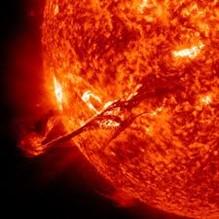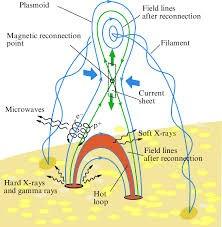Solar Flares: The Most Powerful Events in our Solar System
It may appear that the Sun is a stable star; after all, it has shone steadily for billions of years and should do so for billions of years to come. But the Sun has a magnetic field, and the twisting and turning of the magnetic field in the outer layers of the Sun, on a well-established 11-year cycle, gives rise to a variety of variable effects in its outer layers. The most energetic of these is the solar flare: releasing an amount of energy equivalent to a billion one-megaton bombs in the space of a few minutes, and causing a billion tons of solar material to be ejected into space at a million miles an hour, solar flares not only present an up-close “cosmic laboratory” in which to study physical processes in astrophysical objects, but also a hazard to communications and power systems on the Earth. They also present a possibly fatal hazard to unprotected astronauts.
At WKU we study the processes at work during solar flares: the acceleration of trillions of trillions of trillions of electrons that make intense X-ray bursts when they impact the solar atmosphere, and the magnetohydrodynamics of the solar atmosphere in response to this huge input of energy and electrical current. We use satellites launched by NASA and the European Space Agency, and we perform theoretical models, bit analytic and numerical. We also are developing tools to predict when and where on the Sun a flare is likely. This is not only useful for mitigating their effects, but our results have also been used by rocket-payload instrument teams so that they can time their launches to observe a flare in process.
A community of faculty, staff, and students engaged in better understanding the physical world.
Some of the links on this page may require additional software to view.








